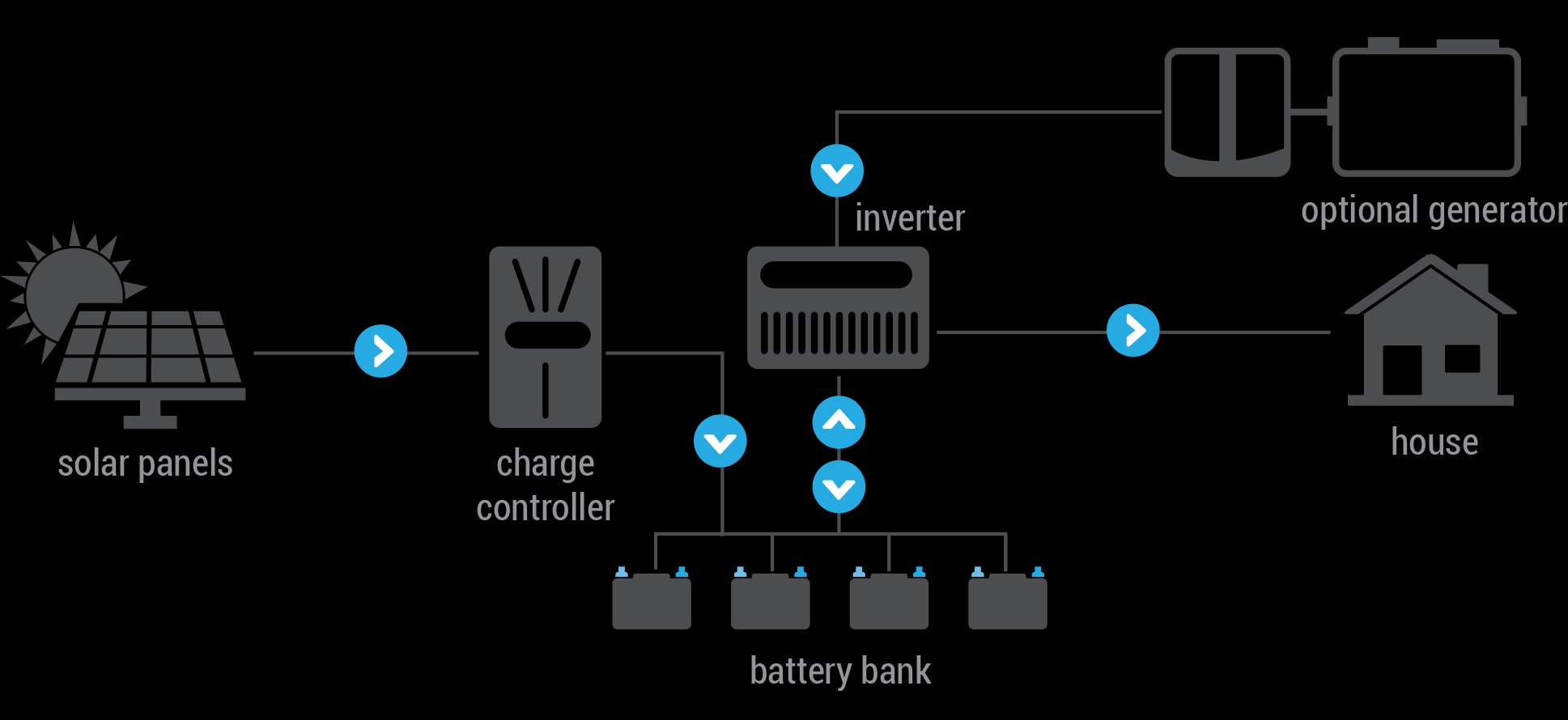Residential Solar Power
Notes on the basic science, typical components and sample configurations of residential solar installations.
Basic off-grid system

The components of a basic off-grid system are as follows:
- Solar panels convert sunlight to electricity and output DC power.
- Charge controller takes DC power from panels, and regulates output.
- Battery bank takes regulated DC output from controller, charges batteries, and outputs DC. Best Solar Charge Controllers
- Backup generator (e.g. gasoline), also ouputs DC to the inverter. Honda’s generators are well-regarded. The Ultra-Quiet 2200i weighs 46lbs, runs 8.1 hours on a single 3.6 litre tank, which costs $4.60 at Nov 2019 Vancouver gas prices of $1.30, and outputs max 2,200 watts (1,800 continuous) at 120 VAC.
- Transfer switch switches two sources of power. In our case: the battery bank and generator. Transfer switches can be manual or automatic (e.g. switch to generator when batteries are depleted).
- Inverter takes 12 volt DC from battery bank, and outputs 120 volts AC, which is what home appliances run on.
- AC load center helps organize load across different outlets and devices.
- Home appliances plug into the outlets.
Misc details
- For top-rated panels, see: Best selling panels in California for 2018.
- A south facing roof is best (assuming you’re in the northern hemisphere). East and west facing are good. North facing is just OK. Optimal angle is 45°. Per Energyhub.org.
-
Clouds are fine.
- “Ironically, solar panel kits work best under cold and cloudy conditions with full sun. This is because temperature af fects the efficiency of a solar panel; a 100-watt panel at room temperature will be become an 83-watt panel in 110 degrees.” - Best Solar Charge Controllers
- Doubling your batteries gives redundancy for a critical-component.
- Lithium Ion batteries: Lighter and cheaper than lead acid. “Because of the better efficiency and deeper discharge depth, Lithium battery banks tend to be only 50-60% of the size of a comparable lead acid bank!” Off-Grid Battery Bank Sizing
- Solar-optimized charge controller: Cheap charge controllers only prevent batteries from overcharging. A charge controller designed for solar (e.g. a Maximum Power Point Tracking (MPPT) controller) provides more efficiency by better resolving the delta between the voltage of the solar panels and the batteries. See: Best Solar Charge Controllers.
- Pure sine-wave inverter: is better for your electronics.
- Motors draw significantly more power during the first few seconds of operation: Can easily be 3x. So buy inverters that have more wattage than you think you need. Some also have two ratings: “surge” and “continuous”.
How much panel capacity?
The simple formula for estimating a solar system is as follows:
(Yearly kWh Usage ÷ 365 days ÷ average sun hours) x 1.15 efficiency factor = DC solar array size required.
To date, my studio apartment’s average kWh consumption has been:
110 kWh/month. That includes a fridge, dishwasher,
washer/dryer, electronics, lights, etc. Times 12 months, that’s
1320 kWh/year.
I’m assuming 3.5 average hours sunlight for Vancouver. That’s the same value as Seattle. ClimaTemps claims an average of 5:01 hours sunlight per day, taking into account historical weather and variations in length of day by season. But I’ll go with the more conservative 3.5 estimate.
With those figures, I get the following:
(1320 ÷ 365 ÷ 3.5) x 1.15 = 1.18 kWIf I used SunPower SPR-X21-335-BLK-D-AC panels (335 W, 21% efficiency), I could use 4 panels x 335W = 1340 watts.
Those panels look to go for about $1 USD per watt, so that’s $1340 USD for the panels. Then there are the costs of other system components and installation.
Units
-
1 watt, flowing for 1 hour = 1 watt hour (Wh).
- 40W lightbulb on for 8 hours = 320Wh
-
1000Wh = 1 kilowatt hour (kWh). This is what our utilities are
billed in.
- 1000W microwave on for 8 hours = 8000Wh = 8kWh
-
Amps x Volts = Watt.
- Fridge runnning at 127V and 2.4A = 305W.
- Using water pipe analogy, volts are water pressure, amps are flow through the pipe, adn watts are what we can do with that energy (e.g. turn a water wheel)
-
Batteries are rated in watt hours
- Yeti 400 battery is 396 Wh. It’s 12 volts x 33 Amp hours = 396Wh.
- A 100W lightbulb would last four hours.
- Solar panels are measured in watts.
Consumption examples
The power draw of portable Macs can be found in System Information > Power > AC Charger Information.
| Device | Watts |
|---|---|
| LED light bulb. E.g. G9 dimmable | 4.5 |
| 55" LED TV. E.g. Vizio P55-F1 | 172 (0.5 standby) |
| MacBook Pro | 86 |
| Freezer. E.g. 115 VAC, 5A draw (2x at peak). | 575 |
In 2019, my average monthly kWh consumption has been 110 kWh.
| Device | kWh / year |
|---|---|
| Gaming PC (with display) | 1400 |
| Gaming console | 134 |
| Average household PC | 246 |
| Fridge. E.g. Kitchen Aid KBRS22KVSS4 | 459 |
Example builds
-
Gambier Island home
- 3.12 KW panels, 40KW batteries, 8.5KW inverter
-
DIY home system
- 123 watt panels x 3, 2 x 232 amp hour batteries.
- VanLife recommended equipment
- VanLife mobile electrical systems guide
- How to Sleep in a Wrangler JK JL 2-Door
